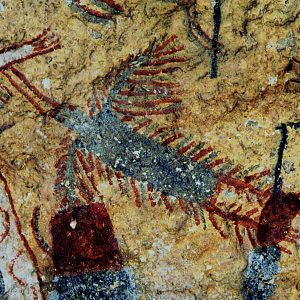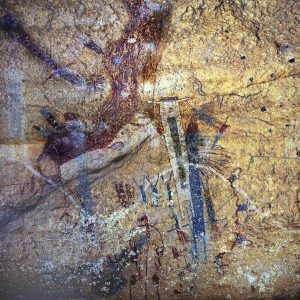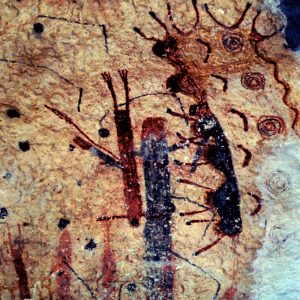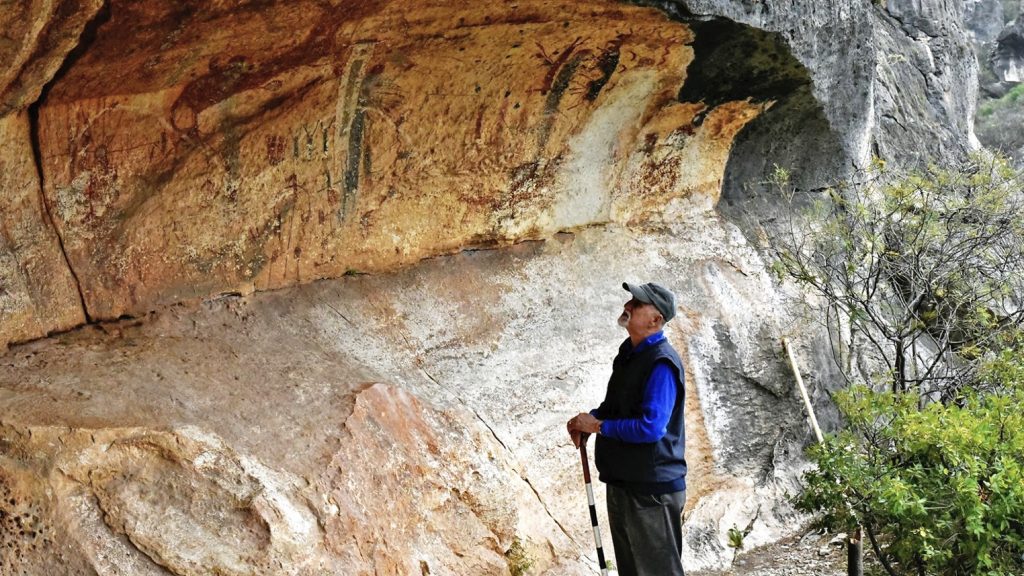
Sacred Landscape in the Lower Pecos
By Harry J. Shafer, PhD, Curator of Archaeology, Witte Museum
There is an ancient, sacred landscape in Texas, bounded by hundreds of colorful pictographs, that includes the Witte Museum’s White Shaman archaeological site. The 2,500-5,000-year-old paintings in the region delineate the sacred landscape of the people of the Lower Pecos that encompasses the canyon systems of the spring-fed Pecos and Devil’s rivers and the confluence with the Rio Grande. The pictographs today are preserved under sheltered overhangs whose walls served as a canvas to the creators.
Over 300 separate sites with paintings are known today, but traces of paint on deteriorated surfaces signal that many more once adorned these canyon walls. This concentration of ancient rock art is unique in American archaeology and the world. Scholars have been studying them for decades, and four separate styles of pictographs have been identified, the oldest and most numerous being the polychrome black, red, yellow and white images of the Pecos River style. The ages have been determined by radiocarbon dating the organic binder used to mix the paint.
The distribution of the Pecos River Style is very restricted to the deep canyonlands and spring-fed rivers. This territory is bounded on the west by the western tributaries of the Pecos River, on the north by the springs of Independence Creek, on the east by the eastern tributaries of the Devil’s River and Sacatosa Creek, and on the south by the Los Burros Mountains of Mexico.
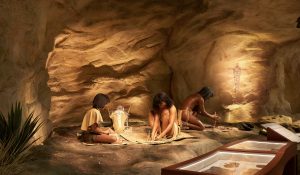
The paintings do not exist in isolation without other traces of material culture. The sheltered overhangs have protected an astonishing inventory of ancient artifacts and, together with the rock art, reveal much about the culture and lifeways of the people. Pioneering efforts to excavate and study this region’s archaeology were led by the Witte Museum’s expeditions of the 1930s. These excavations yielded one of the most comprehensive collections of material culture of the people of the Pecos currently in existence which has been used to tell the stories of the people who painted the rock art.
The Witte Museum stories of the people of the Pecos began with the Basketmaker Hall in the 1930s and changed as better data and understanding became available. The Ancient Texans exhibit that opened in 1986 compared the people of the Pecos to other people in Botswana and Australia. The exhibit also emphasized the role of the shaman as a spiritual leader in reference to the world view and rock art. The growth in the archaeological science has greatly expanded our knowledge of the time depth, physical and cultural environments, climate change, rock art, cosmology and ways of life. This growth has culminated in the studies of the White Shaman site and Witte Museum’s Kittie West Nelson Ferguson People of the Pecos gallery where artifacts of those early expeditions can be seen in their functional context.
The first recording of the rock art (watercolors, made over a three month expedition to capture ancient images in the canyon shelters) was by Witte artist Mary Virginia Carson in 1931. Others followed. Viewers can identify anthropomorphic figures, felines, deer, serpents and enigmatic images in the murals and often draw their own interpretations as to the meaning of the paintings. The rock art, while known by a few, was not seriously studied until the 1980s and 1990s by the late Dr. Solveig Turpin and more recently by Dr. Carolyn Boyd and the Shumla School. Dr. Turpin, following the interpretive theme laid out by W. W. Newcomb in his book Rock Art of Texas Indians, attributed the anthropomorphic figures to shamans and the murals depicting trance experiences using hallucinogens such as peyote.
Recent studies by the Shumla School have determined that the polychrome murals depict stories told by elders and shamans. Boyd has studied the Witte Museum’s White Shaman site for over 20 years using both scientific and ethnographic sources and compared the White Shaman site to murals and codices from Mesoamerica. She has shown that the mural is a single composition created by applying the paint colors in succession. Collaborating with Mexican archaeologists, she compared the motifs in the White Shaman to recorded myths of the Nahua and Huichol Indians of northern and central Mexico and sees a lot of parallels. She theorized that the White Shaman mural depicts the birth of the sun and the dawn of time and changing seasons and more. One recurring theme seen at White Shaman and other sites in the region is the emergence from the Underworld depicting the origins of the people.
The Lower Pecos Canyons are exceptional in that food was bountiful given the landscape of edible plants and lush riverine habitats with fish and other aquatic resources. The production of the rock art was laborious and time-consuming, which means there was time to create and not merely survive. What makes the White Shaman site and the unique painted universe of the Lower Pecos so incredible is that a population of people created these very sophisticated murals that mark this region as their place of origin where their ancestors emerged. It was their sacred homeland, and the rock art served as active, not passive, instruments of their identity.
We should note that there is no evidence to support the idea that the White Shaman mural has a relationship to the springs at the Blue Hole in San Antonio, which is the beginning of the San Antonio River. The painters of the White Shaman and other murals in the Lower Pecos Canyonlands lived thousands of years ago, leaving evidence of a complex culture, where anthropomorphs, zoomorphs and enigmantic figures are found throughout the Lower Pecos area, but not beyond it. The historic identity of the painters is unknown but similarities in material culture and genetic traces point toward Mexico. Indeed, origin stories of the Aztec and Huichol mention their origins as being in the area of the Chihuahuan Desert that would include the Lower Pecos Canyonlands. The distribution of the Pecos River Style marks the territorial boundary of this ancient sacred landscape.
The Witte Museum’s White Shaman site and preserve allows visitors to see for themselves the magnificent mural that tells of the origin stories of the People of the Pecos and experience the landscape that defined the social boundaries of their world. The museum conducts weekly tours from September – May. They can be booked at wittemuseum.org/white-shaman-preserve/.
Witte Museum Members Magazine | Fall 2022
